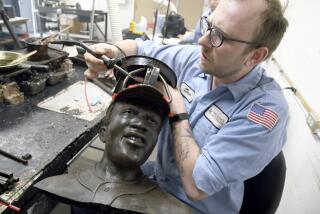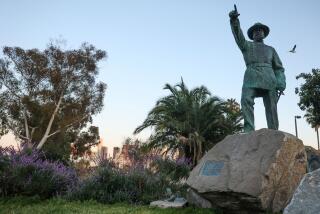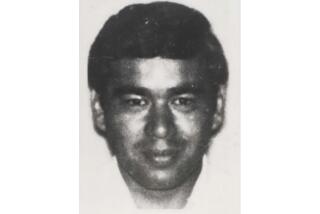Tombstone of Nevada boys who died in 1871 finally returns home
It’s a tale that involves death and marble and well, a bit of fate: A tombstone that marked the grave of two boys killed in 1871 in a fierce Nevada high-country blizzard was recently returned to its resting place after being stolen decades ago and languishing for years along a rural road in Northern California.
Along the way, the stone’s fate involved a thief, a do-gooder, a minister, a historian and, finally, one happy cemetery official overjoyed to have the tombstone returned.
“We’ve been dealing with stolen cemetery stones for years and years,” Candace Wheeler, executive director of the Comstock Cemetery Foundation, told the Los Angeles Times. “But this was one of the weirdest ones because of all the people it tied together. Let’s just say it’s safe to assume that we never figured on seeing that stone again.”
Part of the tale plays out on the historic Comstock Lode, which in the 1850s was the first U.S. discovery of silver ore near what is now Virginia City, Nev. The find drew countless prospectors in search of fame and fortune.
The deaths of the two ranch boys, Henry Jones, 14, and his 9-year-old brother, John, add to the Old West mystique of the tale. Their frozen bodies were found Dec. 24, 1871. As the story goes, their hard-driving father, Robert Jones, had ordered the pair to move cattle from south Reno to his ranch at American Flat, just south of Virginia City, during a storm.
The rancher buried his sons under a simple marble tombstone that explains the tragedy, reading that “death wrapped them in a snowy shroud.”
The stone and the grave sat untouched until the mid-1970s, when a thief stole the stone marker from the Gold Hill Cemetery.
That’s when chance kicked in.
In 1978, hundreds of miles to the west, outside Petaluma, Calif., Jean Hood Mickelsen found a headstone near her mailbox. She contacted the late Rev. Henry Rankin, former pastor of the nearby Two Rock Valley Presbyterian Church.
Efforts to solve the riddle of the homeless tombstone proved futile, but church members left the stone in their own cemetery, propped against the stump of a eucalyptus tree.
Years later, a local historian took an interest in the damaged headstone, by then black and moldy, and reached out to researchers across the region. That’s when somebody saw an Internet image of the stone on the Comstock Cemetery Foundation website.
For years, the foundation had used an old photo of the stone as its logo. Each year at Christmas, Comstock foundation members lay a wreath at the stone’s former site, and residents leave toys and mementos there as well.
Wheller told The Times that the theft launched her into years of research on the Jones family. “It’s really a story of the American West,” she said.
She also completed work on her master’s thesis on why people steal things from graveyards.
“I interviewed people who stole stones and other things, and they said they did it because it looked like no one cared for the cemetery. They saw no fence, no signs, no caretaker, so they felt justified in liberating what they felt like taking,” she said.
“Many people later put things back because they thought it brought a family curse. Others kept the stones as yard art or patio pavers. Amazing.”
Wheeler said she was stunned when she received the call in December telling her that the stone had been located. “My boss told me I had to calm down before I returned the call from the folks in California,” she said. “We were just amazed to hear from this darling caretaker of this little teeny church.
“We went out and got the stone and the minister there said, ‘We don’t know each other, but together, we get to do something right, to put things back the way they should be.’ I couldn’t agree more,” Wheeler said.
A dedication is planned Saturday for the spiffed-up stone, which now rests in peace.
ALSO:
Shell reduces its Arctic drilling ambitions as delays continue
Federal workers who haven’t paid taxes might need new jobs
Chick-fil-A: Today, customers decide -- appreciation or antipathy?
More to Read
Sign up for Essential California
The most important California stories and recommendations in your inbox every morning.
You may occasionally receive promotional content from the Los Angeles Times.











